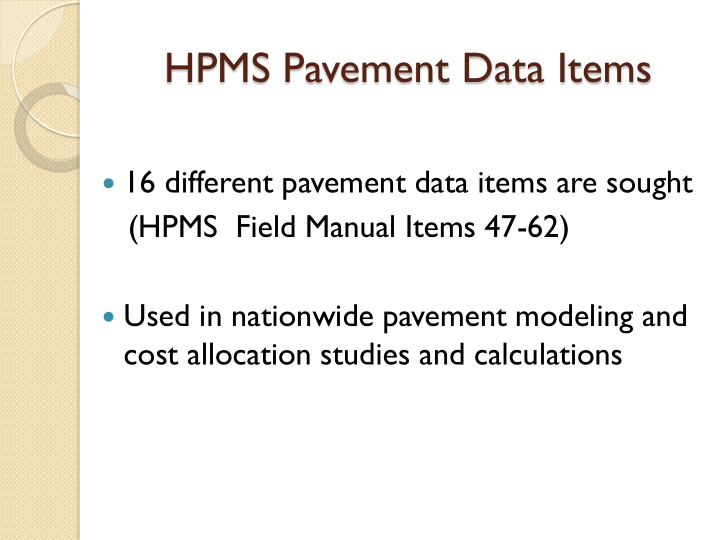



HPMS Pavement Data Items 16 different pavement data items are sought (HPMS Field Manual Items 47-62) Used in nationwide pavement modeling and cost allocation studies and calculations
Pavement Data Input Spreadsheet
Item 47 - IRI International Roughness Index. IRI should be measured on an annual cycle for all Principal Arterials
Item 48 - PSR PSR - Present Serviceability Rating Report PCI (Pavement Condition Index) if that is what you have and we will convert to PSR
PCI to PSR conversion Table
Item 49 – SURFACE TYPE Any change in the surface type is required to be reported after the initial reporting.
Surface Types Code Description 1 Unpaved 2 Bituminous 3 JPCP – Jointed Plain Concrete Pavement 4 JRCP – Jointed Reinforced concrete Pavement 5 CRCP – Continuously Reinforced Concrete Pavement 6 AC Overlay over Existing AC Pavement 7 AC Overlay over Existing Jointed Concrete Pavement 8 AC (Bituminous Overlay over Existing CRCP) 9 Un-bonded Jointed Concrete Overlay on PCC Pavement 10 Bonded PCC Overlay on PCC Pavement 11 Other
Item 50 - RUTTING Average depth of Rutting. Report average of both wheel paths. Report to the nearest .1 inch This data is to be collected on two year cycle.
Item 51 – FAULTING (concrete pavements only - codes 23,4,9,10) The average vertical displacement (difference in elevation) between adjacent concrete joined panels in the direction of travel. Every joint should be measured and the average reported to the nearest .1 inch. This data is to be collected on two year cycle.
Item 52 – CRACKING PERCENT (For AC & PCC pavements) Estimate percent area with fatigue type cracking for AC (asphalt concrete) pavements (typically in wheel path) Percent of slabs with cracking for PCC (Portland Cement Concrete pavements.) This data is to be collected on two year cycle.
Item 53 – CRACKING LENGTH Estimate of relative length in feet per mile (ft/mi) of transverse cracking for AC pavements and reflection cracking for composite pavements where AC is the top surface layer. Consider cracks of at least 6 feet in length. Report in feet/mile [(Accumulative Crack Length in feet/Surveyed Section Length in feet)* 5,280] This data is to be collected on two year cycle.
Item 54 – YEAR LAST IMPROVEMENT The year (completion date) in which the roadway surface was last improved. 0.5 inch or more compacted pavement material must be put in place for it to be considered a surface improvement. Report the best known year. Retain the coded improvement year until another improvement affecting the surface is completed.
Item 55 - YEAR LAST CONSTRUCTION The year in which the roadway was constructed or reconstructed. Report the best known year.
Item 56 - LAST OVERLAY THICKNESS Thickness of the most recent pavement overlay to the nearest .5 inch An overlay is more than 0.5 inch in compacted thickness.
Item 57 – THICKNESS RIGID (PCC pavement) Thickness of rigid pavement to the nearest .5 inch. The thickness should reflect the last improvement on the section. When an improvement is made, consider all new or redesigned base and pavement materials when determining the appropriate value.
Item 58 – THICKNESS FLEXIBLE (AC pavement) Thickness of the flexible pavement to the nearest .5 inch. Report total thickness of all AC pavement layers If PCC has been overlaid on AC composite, report the AC layer thickness under it. If AC has been overlaid on PCC, report the AC layer on top.
Item 59 – BASE TYPE The base pavement type. Base is everything between sub-grade and surface course. Use the code that best describes the layer immediately below the surface layer.
Base Types Code Description 1 No Base 2 Aggregate 3 Asphalt or Cement Stabilized 5 Hot Mix AC (Bituminous) 6 Lean concrete 7 Stabilized Open-graded Permeable 8 Fracture PCC
Item 60 – BASE THICKNESS The thickness of the base pavement to the nearest inch. Base includes everything between sub- grade and surface course. If there are several types of base, report total thickness of all base layers.
Item - 61 Climate Zone and Item - 62 Soil Type FYI – These items will be populated by FHWA.
Recommend
More recommend